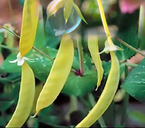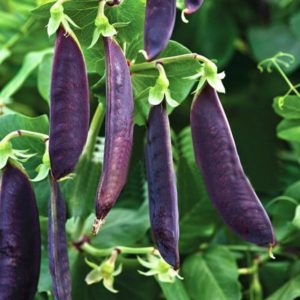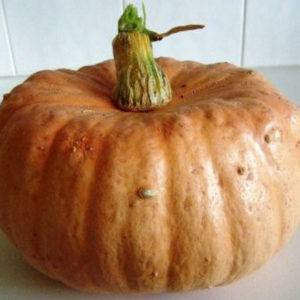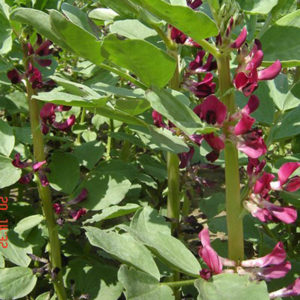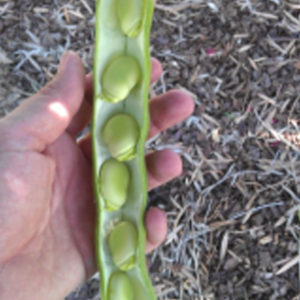-
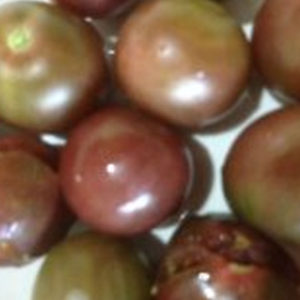 Solanum lycopersicum L. Perfectly round dark red/black fruits with rich, sweet flavour growing on indeterminate plant that needs staking. Research show its origins start in Florida and has been very popular here for the last 5 years. If you have problems with birds these are great because they cant see them! When green fruit starts getting a red hue you know they're ready.
Solanum lycopersicum L. Perfectly round dark red/black fruits with rich, sweet flavour growing on indeterminate plant that needs staking. Research show its origins start in Florida and has been very popular here for the last 5 years. If you have problems with birds these are great because they cant see them! When green fruit starts getting a red hue you know they're ready. -
 Lagenaria siceraria You’ll note by the unusual seed that this is not of the pumpkin or squash family and should be eaten when young like a zucchini. And it’s delicious by all the taste tests. Creamy with great texture. Growing conditions are much like the ‘squash’ Tromboccini and again watching these vigorous plants grow is a delight. Highly recommended and rare.
Lagenaria siceraria You’ll note by the unusual seed that this is not of the pumpkin or squash family and should be eaten when young like a zucchini. And it’s delicious by all the taste tests. Creamy with great texture. Growing conditions are much like the ‘squash’ Tromboccini and again watching these vigorous plants grow is a delight. Highly recommended and rare. -
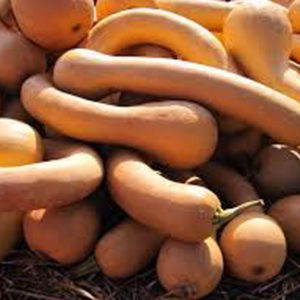
Cucurbita moschate An unusual ‘pumpkin’ in that it’s delicious while still young, picked and eaten like a squash or zucchini. Allowed to mature the skin hardens then Tromboccini should be eaten like a pumpkin. Not as sweet as some it still has great flavour and texture. When baked we added herbs and spices which it absorbed beautifully. Great watching the vines spread either on ground where squashes will ‘curl’ or on fence lines where squashes will hang straight.
-
Out of stock
 Zea Mays This multicoloured corn is beautiful to look at and lovely steamed. Open pollinated ancient, multi coloured actual sweet corn growing 2 metres & more. Has good sugar levels and ready to eat in 90 days after planting. Reportedly found by archaeologists in the Anasazi ruins. Plant as all corn - full sun, rich organic soil and plenty of water.
Zea Mays This multicoloured corn is beautiful to look at and lovely steamed. Open pollinated ancient, multi coloured actual sweet corn growing 2 metres & more. Has good sugar levels and ready to eat in 90 days after planting. Reportedly found by archaeologists in the Anasazi ruins. Plant as all corn - full sun, rich organic soil and plenty of water. -
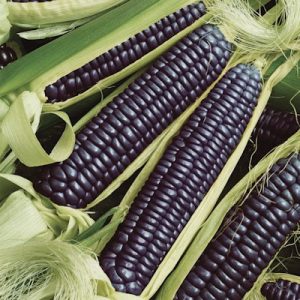 Zea mays This corn is blue to the eye and truly remarkable to grow. This is a rare seed. Blue Hopi corn has so much anthocyanins in it that some say that it is has more antioxidant potential than blueberries. Limited quantities. Considered a staple corn of the Hopi people, this corn can be eaten as a sweet corn when young, or allowed to dry it can be used to make flour. Hopi Blue has a higher protein content than a dent corn and makes wonderful tortillas. The 7 inch, dried blue ears also make great autumn decorations. Plants are 2 metres tall.
Zea mays This corn is blue to the eye and truly remarkable to grow. This is a rare seed. Blue Hopi corn has so much anthocyanins in it that some say that it is has more antioxidant potential than blueberries. Limited quantities. Considered a staple corn of the Hopi people, this corn can be eaten as a sweet corn when young, or allowed to dry it can be used to make flour. Hopi Blue has a higher protein content than a dent corn and makes wonderful tortillas. The 7 inch, dried blue ears also make great autumn decorations. Plants are 2 metres tall. -
Out of stock
 Brassica oleracea A rare combination of cauliflower colours that will all taste delicious yet with subtle differences.
Brassica oleracea A rare combination of cauliflower colours that will all taste delicious yet with subtle differences. -
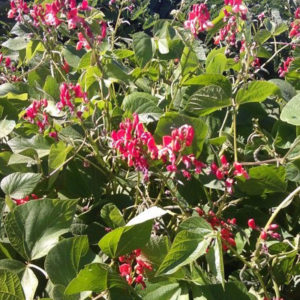
Phaseolus coccineus Originally from the mountains of Central America, Scarlet Runners are often grown as an ornamental as the flowers with contrasting green leaves are dramatic & beautiful. Planted in spring the climber can produce flowers all summer till autumn when the beans begin to set in the cooler weather. Beans when picked young are long flat tender and very tasty. Or let beans dry on plant and are considered tasty.
-
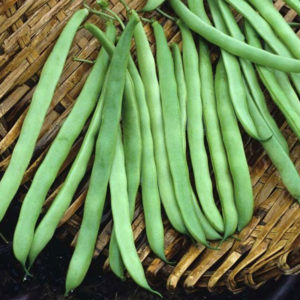 Phaseolus vulgaris This lovely ‘politically incorrect’ bean derives its name for its ease of growing and one of the first stringless beans making preparation much easier…for the housewife nearly 200yrs ago! Tender, productive fleshy broad green climber up to 2 metres. Rare now and needing reviving as its flavour compares well with today's good green bean.
Phaseolus vulgaris This lovely ‘politically incorrect’ bean derives its name for its ease of growing and one of the first stringless beans making preparation much easier…for the housewife nearly 200yrs ago! Tender, productive fleshy broad green climber up to 2 metres. Rare now and needing reviving as its flavour compares well with today's good green bean. -
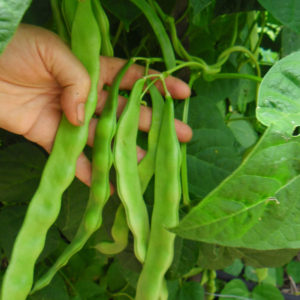
Phaseolus vulgaris This bean was a gift from a gentleman in Pearcedale who gave us a handful literally. It took the next year to grow out and realize what a lovely gift it was. Tall climber with pink beautiful flowers, then long 30cm truly flat pods very tender even at the early stages of the seed swelling. Great cooked with onions, garlic, tomatoes, bay leaves seasoning and the beans thrown in whole and cooked for the last 10 minutes.
-
 Phaseolus vulgaris We’d been after this climber for a long time and are very grateful. Up to 2 metres needing staking or strong trellis the rich green leaf contrasts beautifully with the streaks of red/pink/cream that makes this bean productive, ornamental and delicious. Unlike other beans pick when swollen with seeds then dry or better still steam while green and tender, a very sort after delicacy.
Phaseolus vulgaris We’d been after this climber for a long time and are very grateful. Up to 2 metres needing staking or strong trellis the rich green leaf contrasts beautifully with the streaks of red/pink/cream that makes this bean productive, ornamental and delicious. Unlike other beans pick when swollen with seeds then dry or better still steam while green and tender, a very sort after delicacy.

